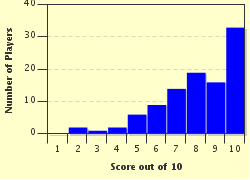Quiz Answer Key and Fun Facts
1. If you get a TEAR IN this part of your eye it is a significant medical emergency.
2. There is often a RACE ON to achieve a successful transplant of this part of your eye.
3. If someone shines a bright light in your eye, it may help to keep your stiff upper LIP UP.
4. Getting an ASHY EEL in your eye can be a painful and irritating experience.
5. There's definitely something funny about HUMOROUS VIRTUE. Perhaps it's floating about in your eye?
6. If you discover a problem with the connection between your eye and your brain, consulting a PORCINE VET will probably not help you very much.
7. Don't ACCEPT LESS when it comes to your vision. Visit your optician to get a new prescription!
8. Strangely enough, INKY PEE is not generally a symptom associated with this itchy condition.
9. It's probably best not to CONNECT SALT with your eye unless specifically recommended by your optician.
10. If something upsets you, try not to STARE too hard at it.
Source: Author
Fifiona81
This quiz was reviewed by FunTrivia editor
spanishliz before going online.
Any errors found in FunTrivia content are routinely corrected through our feedback system.

